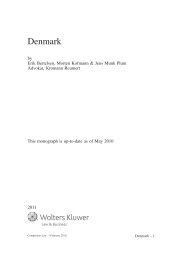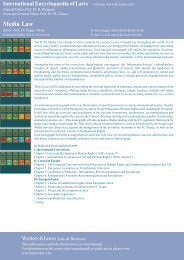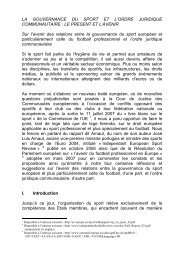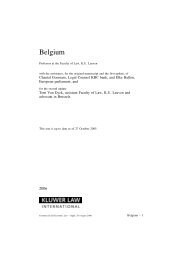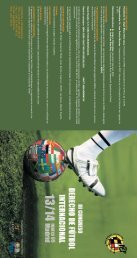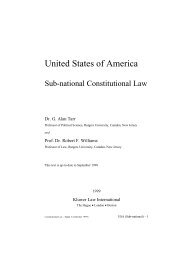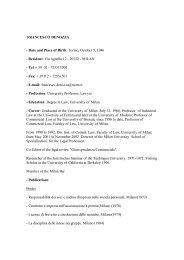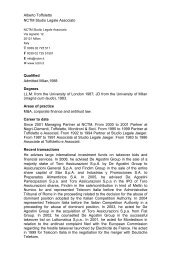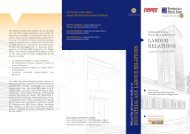Catalogue - International Encyclopaedia of Laws
Catalogue - International Encyclopaedia of Laws
Catalogue - International Encyclopaedia of Laws
You also want an ePaper? Increase the reach of your titles
YUMPU automatically turns print PDFs into web optimized ePapers that Google loves.
<strong>International</strong> <strong>Encyclopaedia</strong> <strong>of</strong> <strong>Laws</strong><br />
Tort Law<br />
Editor: Pr<strong>of</strong>. Ingrid Boone E-mail: ingrid.boone@ugent.be<br />
In an international encyclopedia, a proper place is definitely to<br />
be devoted to the Law on Tort. This legal area is important for<br />
lawyer and citizen alike. The problems <strong>of</strong> prevention <strong>of</strong> harm<br />
and loss allocation are not only extremely diverse but also<br />
universal and fundamental. This traditional branch <strong>of</strong> law not<br />
only tackles questions which concern every lawyer, whatever<br />
is his legal expertise, but it also concerns on a worldwide scale<br />
each person’s most fundamental rights, such as his right to<br />
bodily integrity, his right to a manworthy existence and his<br />
property rights. The way a legal system protects rights and<br />
interests through, among others, tort law co-determines the<br />
degree <strong>of</strong> civilisation and the development <strong>of</strong> a given society.<br />
However, no matter how fundamental tort issues may be, it is<br />
striking how the solutions <strong>of</strong>fered in one system can be very<br />
different and sometimes quite diverse from those in another.<br />
There are basic differences in approach between the legal<br />
systems and the dividing line does not always match the classic<br />
divide between the countries <strong>of</strong> the Civil Law tradition and<br />
those belonging to the Common Law tradition.<br />
In the General Introduction, particular attention will be paid to<br />
the aims <strong>of</strong> the law <strong>of</strong> Torts and to the distinction between tort<br />
and crime and to the relationship between tort and contract (is<br />
concurrence between tortious liability and contractual<br />
responsibility permitted or not? what about precontractual<br />
liability?). For each country, the scope <strong>of</strong> protection will be<br />
tackled as well (are all interests equally protected?).<br />
The monograph is then divided into six Parts: Liability for One’s<br />
Own Act; Liability for Acts <strong>of</strong> Others; Forms <strong>of</strong> Strict Liability;<br />
Defenses and Exemption Clauses; Causation; Remedies. Each<br />
Part in its turn is divided into Chapters. Thus, the first part<br />
devotes a chapter to Specific Cases <strong>of</strong> Liability, such as<br />
pr<strong>of</strong>essional liability and liability <strong>of</strong> public bodies, abuse <strong>of</strong><br />
rights and injury to reputation and privacy. The authors may<br />
feel free to add other specific cases which are peculiar to their<br />
legal system.<br />
Each monograph follows the outline below:<br />
The Author. Table <strong>of</strong> Contents. List <strong>of</strong> Abbreviations. General<br />
Introduction. Selected Bibliography<br />
44<br />
Part I. Liability for One’s Own Acts.<br />
1. General Principles.<br />
2. Specific Cases <strong>of</strong> Liability (are all tort feasors<br />
subject to the same rules).<br />
Part II. Liability for Acts <strong>of</strong> Others.<br />
1. Vicarious Liability.<br />
2. Liability <strong>of</strong> Parents, Teachers and Instructors.<br />
3. Liability for Handicapped Persons.<br />
4. Liability for Things and Animals.<br />
Part III. Forms <strong>of</strong> Strict Liability.<br />
1. Road and Traffic Accidents.<br />
2. Product Liability.<br />
3. Liability for Service.<br />
4. Environmental Liability.<br />
5. Others.<br />
Part IV. Defenses and Exception Clauses.<br />
1. Limitation <strong>of</strong> Action (suspension and interruption).<br />
2. Grounds <strong>of</strong> Justification.<br />
3. Contributory Fault.<br />
4. Exemption Clauses.<br />
Part V. Causation.<br />
Part VI. Remedies.<br />
1. General Principles.<br />
2. Kinds <strong>of</strong> Damages.<br />
3. Assessment and Compensation <strong>of</strong> Damages.<br />
4. Personal Injury and Death.<br />
5. Various Damages (property) .<br />
6. Interference with Collateral Benefits.<br />
7. Other Remedies.<br />
Index<br />
Current Contents<br />
FRONT MATTER: <strong>International</strong> Advisory Board;<br />
<strong>Encyclopaedia</strong>s and Editors; Introducing the<br />
<strong>International</strong> <strong>Encyclopaedia</strong> <strong>of</strong> <strong>Laws</strong>; Curriculum Vitae<br />
<strong>of</strong> the General Editor.<br />
GENERAL SECTION: List <strong>of</strong> Contributors; Introducing<br />
the <strong>International</strong> <strong>Encyclopaedia</strong> <strong>of</strong> Tort Law;<br />
Curriculum Vitae <strong>of</strong> the Editor.



